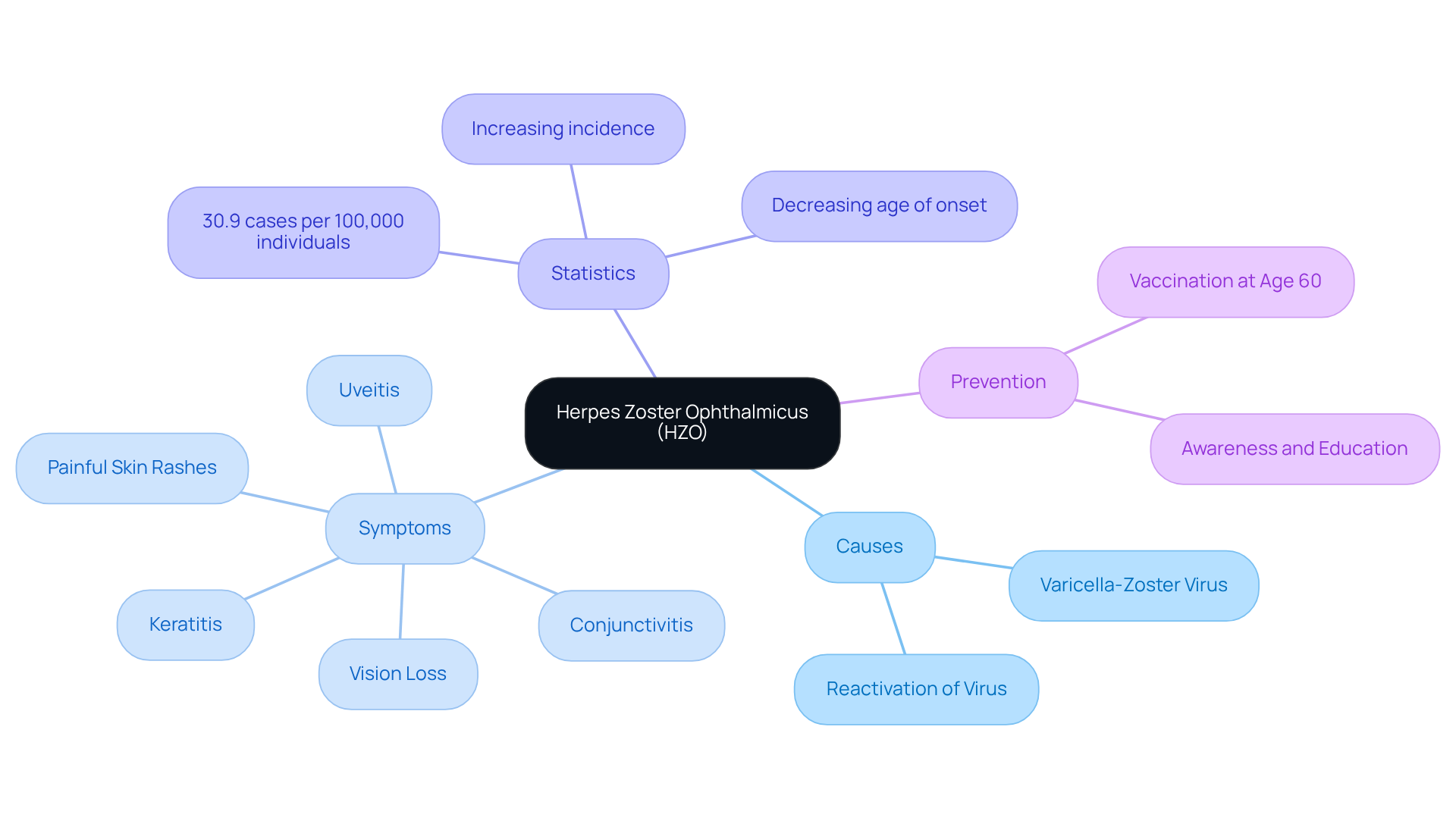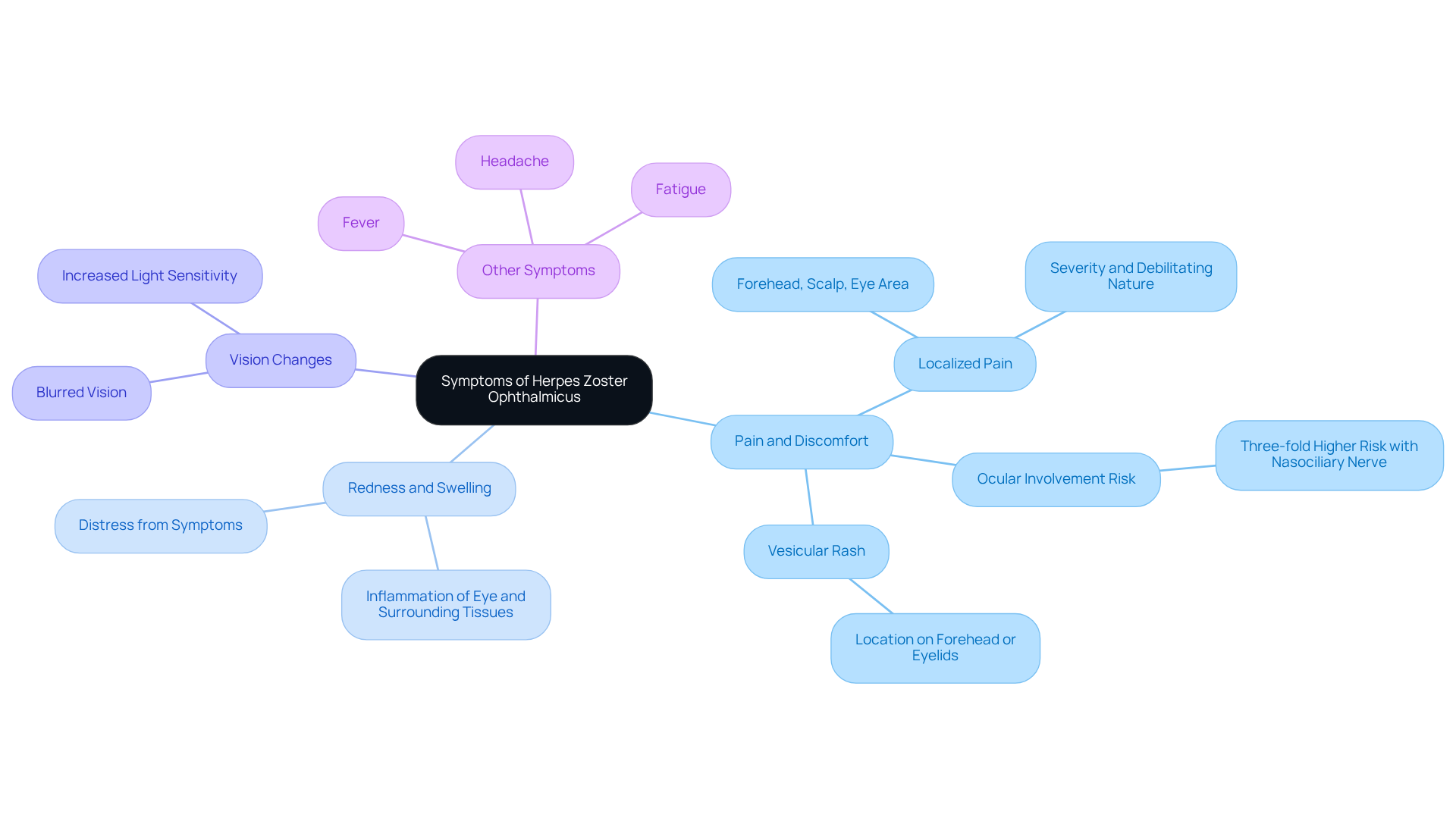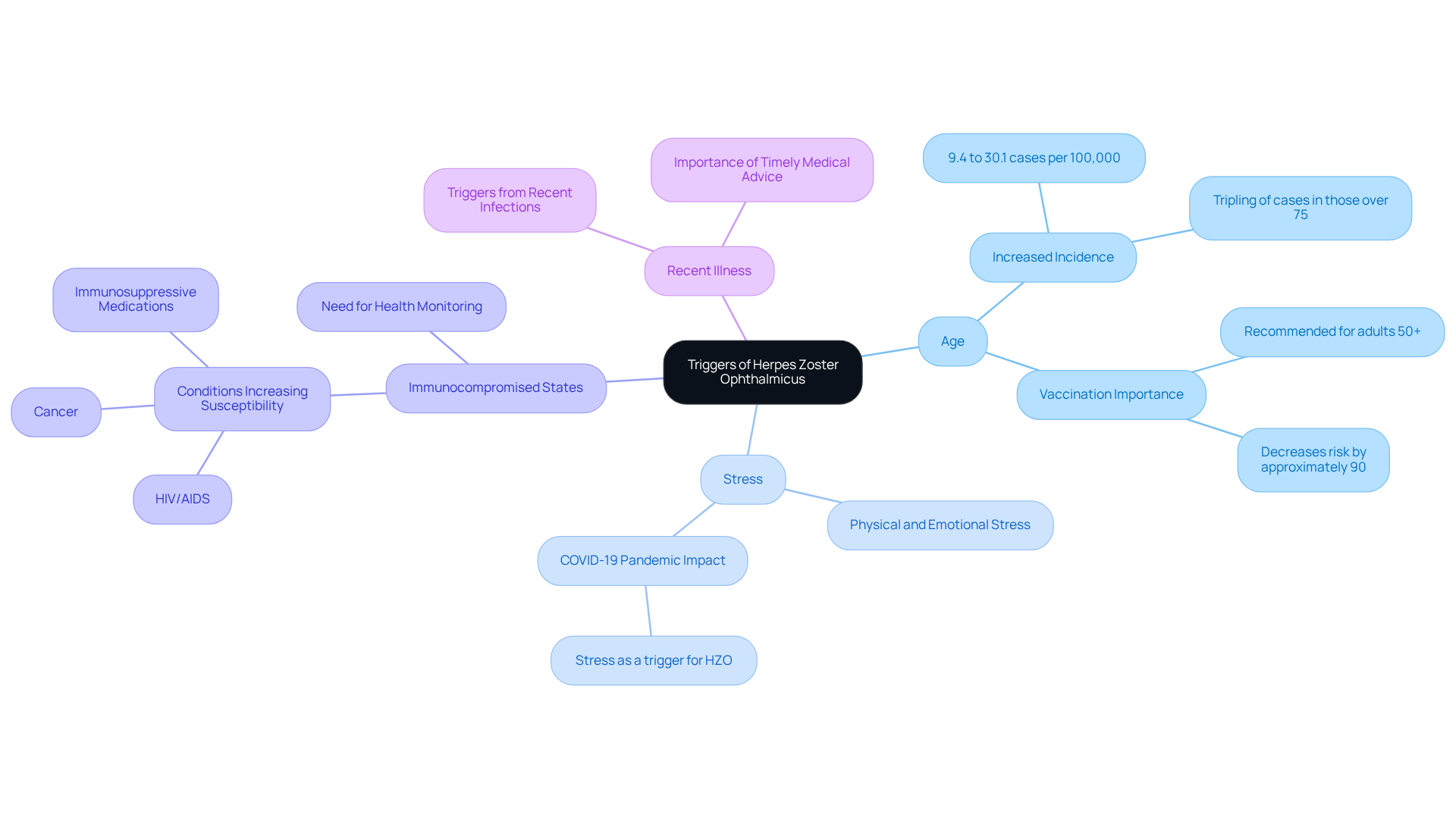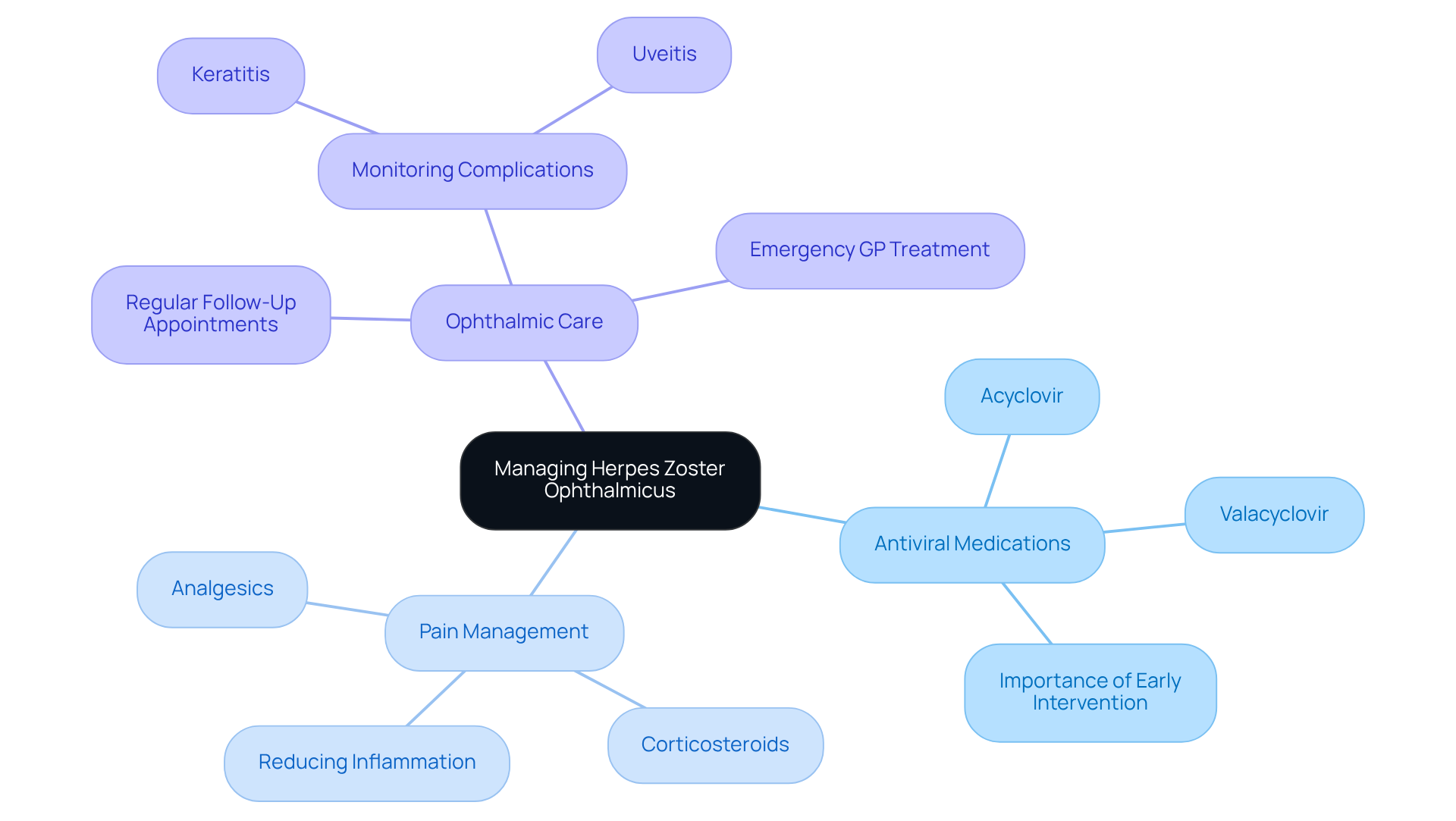Posted by: Northwest Eye in General on August 17, 2025
Overview
Herpes zoster ophthalmicus (HZO) can be a concerning condition, as it is a viral infection resulting from the reactivation of the varicella-zoster virus. This can lead to inflammation that significantly affects eye health, potentially resulting in vision loss if not addressed promptly. We understand that recognizing symptoms early can be overwhelming, but it is crucial for your well-being.
Understanding the triggers for reactivation is essential, and we want you to know that you are not alone in this. Many individuals experience similar challenges, and there are effective treatment strategies available.
- Antiviral medications
- Regular ophthalmic care
can help mitigate complications and improve your health outcomes.
We encourage you to seek care and discuss any concerns with your healthcare provider. Remember, you deserve support and reassurance throughout this process. Together, we can work towards maintaining your eye health and ensuring the best possible outcomes.
Introduction
Herpes zoster ophthalmicus (HZO) is a viral infection that can significantly impact your eye health, arising from the reactivation of the varicella-zoster virus. As the incidence of this condition continues to rise, we understand that it can be concerning. Recognizing its symptoms, causes, and treatment options is vital for effective management. With the potential for severe complications, including vision loss, it’s common to feel anxious about how to identify the early signs of HZO. How can you navigate the complexities of treatment to safeguard your eye health? We are here to help you through this process.
Define Herpes Zoster Ophthalmicus: Overview and Significance
(HZO) is a viral infection that occurs due to the reactivation of the varicella-zoster virus, which is the same virus responsible for causing chickenpox. We understand that hearing about this condition can be concerning, especially since it primarily affects the ophthalmic branch of the trigeminal nerve. This can lead to inflammation with serious implications for your . It’s important to recognize that herpes zoster ophthalmicus can result in , such as keratitis, uveitis, and even if not addressed promptly.
Statistics show that about 30.9 out of every 100,000 individuals in the United States develop HZO, and the incidence is increasing while the age of onset is decreasing. This underscores the importance of being vigilant. Corneal issues can occur in approximately 65% of cases, which highlights the need for . We want you to know that symptoms can vary widely, from painful skin rashes to like conjunctivitis and keratitis. It’s common to feel overwhelmed, but can make a significant difference.
is essential for both you and your healthcare provider, as it facilitates effective symptom management and reduces the risk of long-term vision impairment. Furthermore, we encourage vaccination against shingles at age 60 to help prevent herpes zoster ophthalmicus and its associated complications. At Northwest Eye, we are here to help you through this process, offering resources and support to navigate your eye care journey. We also provide , such as , glaucoma, and diabetic retinopathy, ensuring you feel informed and supported every step of the way.

Identify Symptoms: Recognizing Herpes Zoster Ophthalmicus
Symptoms of typically manifest in ways that may be concerning for you:
- : You might experience localized pain around your forehead, scalp, or eye area. This pain can be severe and debilitating. It’s important to note that individuals with herpes zoster ophthalmicus affecting the nasociliary nerve have a three-fold greater risk of compared to those without lesions affecting the tip of the nose. A vesicular rash may develop on your forehead or eyelids in herpes zoster ophthalmicus, following the distribution of the affected nerve. This rash is a hallmark sign that can aid in early diagnosis.
- Redness and Swelling: Inflammation of the eye and surrounding tissues is common, leading to noticeable redness and swelling, which can be distressing.
- : You may find that your vision becomes blurred or that you are more sensitive to light, which can significantly impact your daily activities.
- Other Symptoms: Accompanying symptoms such as fever, headache, and fatigue may also arise, indicating a systemic response to the viral infection.
is crucial for effective management of herpes zoster ophthalmicus and can help prevent long-term complications such as . We understand that can greatly enhance your health outcomes. As noted by experts in the field, “This study highlights the possibility of preventing an increase in eye diseases and their associated health costs through sustainability, taking into account that this aim can only be reached through environmental, social, and economic balance.” Understanding these symptoms and their implications is essential for and others concerned about their . We are here to help you through this process.

Explore Causes: Understanding the Triggers of Herpes Zoster Ophthalmicus
occurs when the varicella-zoster virus reactivates after being dormant in the body due to a previous chickenpox infection. We understand that this can be concerning, and several factors can trigger this reactivation, including:
- Age: due to a decline in immune function. Studies indicate that the incidence of Herpes Zoster Ophthalmicus rose from 9.4 to 30.1 cases per 100,000 people over a 12-year period, particularly affecting those over 75, who experience a tripling of cases. This highlights the importance of vaccination in this demographic, which can provide reassurance and protection.
- Stress: It’s common to feel overwhelmed by physical or emotional stress, which can weaken the immune system. The COVID-19 pandemic has illustrated how the might trigger the development of herpes zoster ophthalmicus. We recognize how challenging this can be.
- : Conditions such as HIV/AIDS, cancer, or medications that suppress the immune system increase susceptibility. This vulnerability underscores the need for vigilant health monitoring in these populations, and we are here to help you through this process.
- : Any recent infection or illness can trigger the virus. Understanding these triggers can help you take and seek timely medical advice, which is important for your well-being.
Recognizing these factors can empower you to participate in proactive health oversight and discuss with your healthcare providers. The recombinant herpes zoster vaccine is recommended for adults aged 50 and older and decreases the chance of getting herpes zoster by approximately 90%. This makes it a crucial preventive measure, and we encourage you to consider it for your health.

Implement Treatment Strategies: Managing Herpes Zoster Ophthalmicus
Managing (HZO) can feel overwhelming, but we want you to know that is within reach. A multifaceted approach, including , , and ongoing , is essential to navigating this condition. Here are some key strategies that can help you:
- Antiviral Medications: It’s crucial to start antiviral therapy promptly with medications like acyclovir or valacyclovir. Early intervention can significantly reduce both the intensity and duration of the infection, lowering the risk of complications. Remember, two-thirds of cases of herpes zoster ophthalmicus occur in individuals over 50, which highlights the importance of seeking treatment as soon as possible.
- Pain Management: We understand that discomfort can be a major concern. Analgesics or corticosteroids may be prescribed to help relieve pain and reduce inflammation, making your recovery more comfortable.
- Ophthalmic Care: Regular follow-up appointments with an ophthalmologist are vital for monitoring any potential complications, such as keratitis and uveitis. This ongoing care allows for if issues arise. As emphasized by The College of Optometrists, herpes zoster ophthalmicus can pose serious risks to your vision, so staying proactive is key.
, including its symptoms and the importance of early treatment, can greatly improve your outcomes. When patients are empowered with knowledge, they are more likely to seek prompt medical attention, which can lead to . The Clinical Management Guidelines highlight the need for and possible urgent referrals to hospital eye services for effective care.
By embracing these strategies, healthcare providers can support you in managing herpes zoster ophthalmicus effectively, significantly reducing the risk of long-term complications. We are here to help you through this process.

Conclusion
Herpes zoster ophthalmicus (HZO) is a serious viral infection that can significantly impact eye health, arising from the reactivation of the varicella-zoster virus. We understand that this condition can lead to painful symptoms, inflammation, and even severe complications like vision loss. It’s crucial for both patients and healthcare providers to recognize HZO early, as prompt intervention can greatly enhance outcomes and improve quality of life.
Throughout this article, we have explored important insights into the symptoms, causes, and treatment strategies for HZO. You may experience symptoms ranging from localized pain and a vesicular rash to redness, swelling, and changes in vision. Factors such as age, stress, immunocompromised states, and recent illness can trigger this condition. This highlights the importance of awareness and preventive measures, including vaccination. Effective management typically involves antiviral medications, pain relief, and regular ophthalmic care to monitor for any complications.
The importance of recognizing and addressing herpes zoster ophthalmicus cannot be overstated. By empowering you with knowledge about this condition and encouraging proactive health measures—such as vaccination and timely medical intervention—we can significantly reduce the risk of long-term complications. Staying informed and vigilant is essential in safeguarding your eye health and ensuring a better quality of life for those at risk of HZO. Remember, we are here to help you through this process.
Frequently Asked Questions
What is herpes zoster ophthalmicus (HZO)?
Herpes zoster ophthalmicus is a viral infection caused by the reactivation of the varicella-zoster virus, which is the same virus responsible for chickenpox. It primarily affects the ophthalmic branch of the trigeminal nerve and can lead to serious eye health issues.
What are the potential complications of HZO?
HZO can result in significant eye issues, including keratitis, uveitis, and even vision loss if not addressed promptly.
How common is herpes zoster ophthalmicus?
Approximately 30.9 out of every 100,000 individuals in the United States develop HZO, and the incidence is increasing while the age of onset is decreasing.
What percentage of HZO cases involve corneal issues?
Corneal issues can occur in approximately 65% of HZO cases.
What are the symptoms of herpes zoster ophthalmicus?
Symptoms can vary widely and may include painful skin rashes as well as serious ocular issues like conjunctivitis and keratitis.
Why is it important to understand herpes zoster ophthalmicus?
Understanding HZO is essential for effective symptom management and reducing the risk of long-term vision impairment.
What preventive measure is recommended against herpes zoster ophthalmicus?
Vaccination against shingles is encouraged at age 60 to help prevent herpes zoster ophthalmicus and its associated complications.
What resources are available for individuals dealing with HZO?
Northwest Eye offers resources and support for navigating eye care, including information on other conditions such as cataracts, glaucoma, and diabetic retinopathy.






